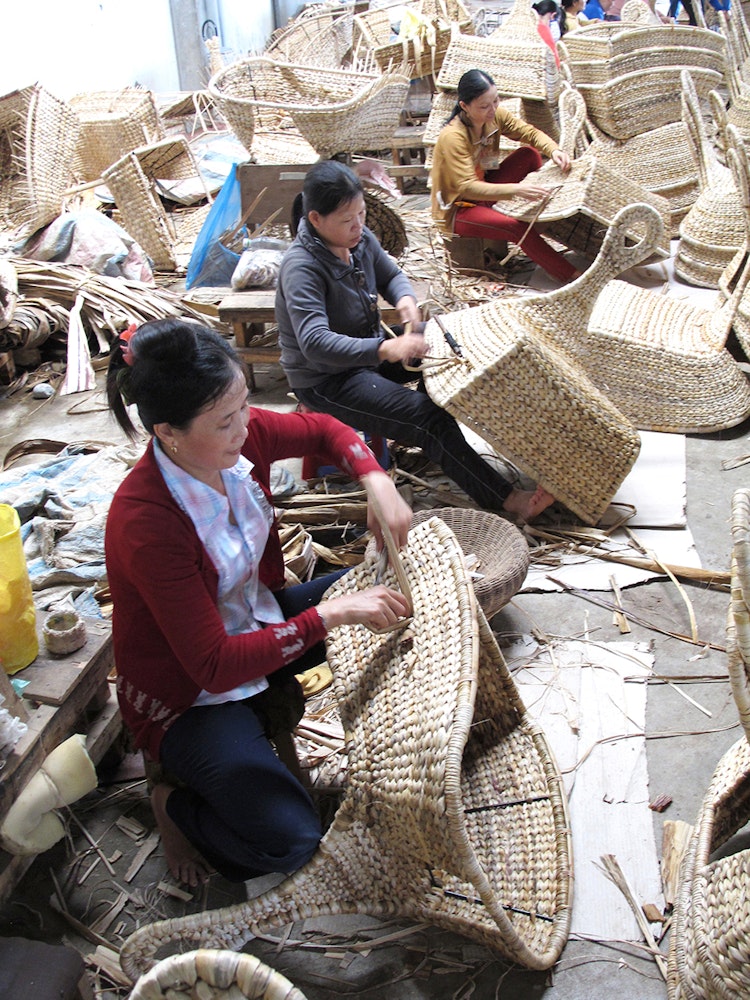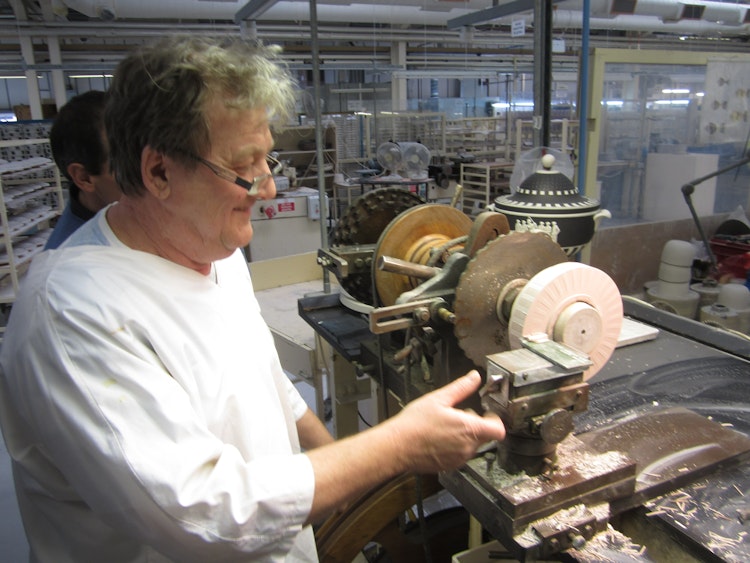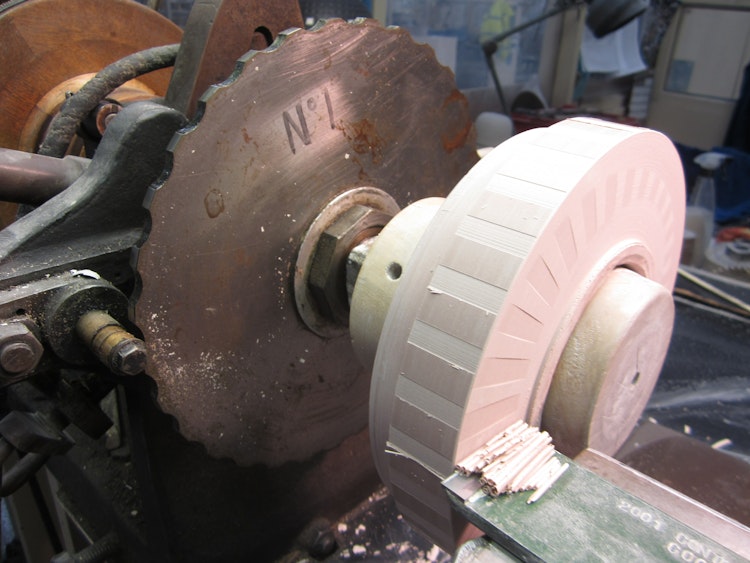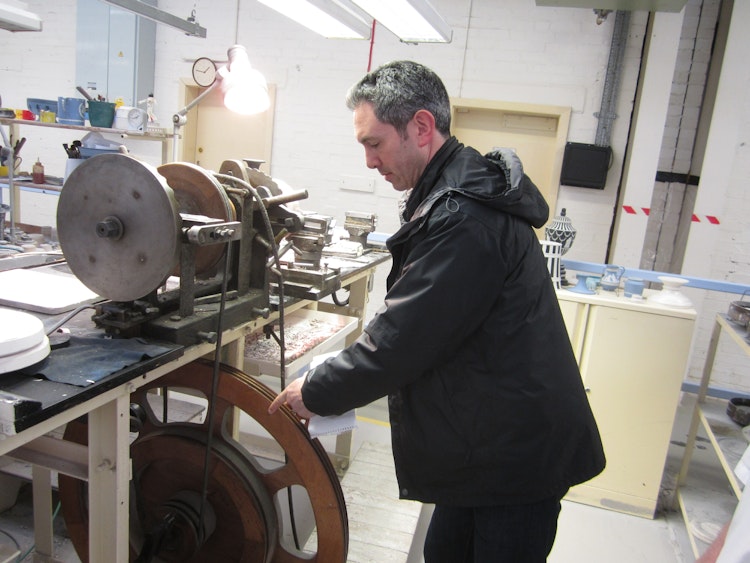

Jessica Hemmings
Jessica Hemmings sat down with Ezra Shales to speak with him about topics he raises in his book The Shape of Craft. The book considers how things get made and the people who make them. In this conversation, Hemmings talks with Shales about industry, technology and material empathy.
Welcome Ezra to Gothenburg where you are a Fulbright Fellow here at HDK this spring. I understand that your recent book, The Shape of Craft (Reaktion Books: 2017), draws on material you used when teaching at Alfred University in upstate New York. You took a number of trips with students to visit local factories. How did your interest in teaching in this way emerge?
‘I have always been a big believer in gallery and museum education and museum visits. I have a background in museum education and I am happier, in fact, to have a conversation where you are circling an object and engaging in first hand observation than I am talking about a screen projection in a dark room. In some ways the magic of art history is born of photographs, but actually knowing art comes only with direct apprehension. You can look back in time and the magic lantern was this exciting experience which allowed people to cross time and see across continents at a time when that kind of travel was prohibitive. But we often forget that it was really born of close looking. I took a class with Leo Steinberg who told me he projected slides of Michelangelo’s Sistine Chapel on the ceiling of his apartment in Manhattan and would draw them.’
To force his body to experience an awkward position?
‘Yes, but also close, attentive looking. Steinberg grew up in London as a refugee in London from World War II and he first fell in love with Michelangelo as a set of postcards he studied in the bomb shelter. So that is one form of magic – the camera bringing that aura of the object into the hands of a refugee. But then to dive deep you need primary engagement. I love to bring students into studios or museums to look at things. The cumulative story of art history is generational aggregates of alternative details, or lateral comparisons between new presents and other pasts. Alfred University is in a very remote place in western New York State, which I often describe in terms of the Erie canal (built 1825-29) being the last exciting thing that happened there economically. It is the rust belt, like Birmingham or Manchester in England. We were far from urban centres and I was already conducting research by going to places like Stoke-on-Trent in England. Walking past production to visit the archives I became interested in the people. I was also noticing how many factories were closing between 2001 to 2008. In my own research I was realising how contemporary production is like sand: it is not static. You have to catch it in the moment. I think we are all very aware of the way ceramic factories and also other factories have left western Europe.’
And textiles factories…
‘Yes, textiles, and glass have moved overseas. But it is more interesting to get away from the generalisations. In western New York State everyone knows the name Kodak. It was interesting for me to find these fascinating bits of intellectual property that had spun off from Kodak but remained in the area of Rochester. I could take students to visit a lens grinding facility building units for satellites which no one would have thought was in the region. Getting entry was about knocking on doors and making calls and tracing factory lineages. I started a course called Art and Industry after the Herbert Read book of 1934. Many of my students were first generation college attendees; some of their parents worked in factories or they had a relative who worked in the factory we were visiting. They had never connected that work to their own interest in materials or thought if studio work connects to factory work once you scale it up. There were historical reasons, socio-economic reasons, and there were also human reasons to visit manufacturing. It was exciting and fun and unpredictable for us to go on a factory tour. Then we would eat lunch with the people we met and interview them: oral histories of artisans. To move away from studying the canon and move towards studying people, processes, material and tools in a much more fluid way was very exciting.’
‘In my own research I was realising how contemporary production is like sand: it is not static. You have to catch it in the moment.’
The 'everyday' as a research topic has now been taken up by many disciplines. But the factory remains something of a blind spot in craft discourse. We often use the factory as an emblem of all that craft does not stand for, maybe particularly, the idea of the hand. You talk a lot in the book about the presence of the hand and high levels of expert manual skill that are much more aligned to craft discourse but found in the factory. Where did the idea start?
‘I have always been interested in watching people work. In my book I mention watching Walt Dewey sanding floors – pipe in mouth, no respirator – taking his shoes and socks off to go over the floor with his feet when he had finished. He tasted the floor with his feet to check his work. He was interested in quality in a deep way (Shales 70-71). I certainly don’t think anything in art history or museums got me thinking about this. I think it is more about everyday life experiences. We often sell short our own everyday life experience and those are things we need to bring to the table to guide research. You will learn a lot more by looking at an object yourself than by reading some sort of culture written by committee. And yet people in a museum spend more time reading a label than looking at an object. Trust yourself more, is my message to students.’

I am interested in the difference between observing – close viewing, close reading – and doing. You begin the book by debunking some myths about historical photographs. Close reading can show us other narratives. But how does that type of observational relationship with the object compare to something that is embodied? What is the difference between me watching someone check the sanded floor with their feet and my feet learning to do that work?
‘You do learn from material manipulation, if you are reflecting and paying attention at the same time. There are ways in which that kind of disciplinary rambling does not make sense to people committed to fine art, but does fit into both craft and design. Craftspeople need to tend to their tools, sharpen their blades, and are generally searching for subtler differences in their toolkits. We are still wondering about tools. There is a pure wonder to materiality that is still relished. But I think you are right, in many ways by situating craft in the factory I am asking people: Hey, let’s run into a brick wall that has existed so long in the craft field. I think it is also because we are lazy and define craft against things and reactively that we have a monolithic understanding of a factory. We label things not factory made and handmade. We neglect to differentiate the range between the unique and mass production. Exquisite things exist between serial and mass production. No Steinway piano sounds alike, and no piano has ever been made by one person alone.’
Earlier this month with the HDK students you also mentioned precedents to Fordist production models in Chicago’s abattoirs?
‘Yes Siegfried Giedion writes about this is Mechanisation Takes Command (1948): a moving dis-assembly line for pigs.’
But these are our myths, for example the innovation of Fordist production ideas, which makes them hard to rewrite.
‘It is no different than technology. My son says to me, a ten-year-old child, let’s go to a technology store. It could be a glass blowing shop. But he defines technology in one-dimensional terms: for him it is an electronics store. A hammer is a wonderful piece of technology – does a hardware store count as a technology store? Spinning, twisting yarn, is a technology. Is a yarn store a tech shop?’


Another word that comes up quite a few times in your book is empathy: “This is the physicality of craft, which one cannot sense from pictorial illusion – again, experience is the only way into accurate empathy.”1 What do you mean by empathy as a material understanding?
‘Going into factories and meeting people and then understanding that they have material intelligence which you lack is eye-opening. Suddenly you empathise with them in a certain way. I built the issue of empathy up in the book because I do think that you can extend the issue of empathy to materials, to tools, as well as people. I think we are often taught, at least I was taught, the concept of truth to materials. It is a noble idea and it sounds good but what is the truthful use of cotton? There are lots of ways you can transform it. Wood can be rough; or wonderfully smooth. We enjoy craggy stone and sleek, polished stone. Truth to materials would be good to get out of our whole universe as a weird religious dogma. Empathy to materials is a much more useful way to build up knowledge educationally. I do think that physically inhabiting different materials builds our understanding. There are dozens of materials that expand and build our tactile knowledge and that is about building empathy. This is going to sound old fashioned but digital devices don’t build empathy. We know they don’t build empathy via emails and we know that they don’t build empathy via social media platforms. They build as much misunderstanding and disinformation about materials.’
What about digital platforms used to organise political protest? That seems like a type of empathy generated online?
‘There are wonderful ways the internet can be used to rally protesters or to discover an obscure craft. But often Facebook builds herds, not nerds. I am a huge advocate of watching things get made on YouTube to figure out how people do make bricks or cymbals or build a pole lathe. But materiality is really important to get us to see the factory as a place that has been a part of society for so long. Especially now with all the green washing and eco-double speak we are encouraged to have a consumer distance from objects and materials and processes. I am an avid user of technology for searches and databases. We have so much information we have access to. But in terms of materials we are in a real moment of crisis in overspecialisation and distance. I think if everyone in their first year of arts education only used plaster, instead of specialising, that might be more interesting. There are ways that different tools and different materials get side lined and they are interesting to put back into play.’

Has education become too materially specialised?
‘I think that is has become too remote, number one. People are distanced from work itself. I don’t think it would be bad if students were learning how to do plastering or plumbing. All of those materials are part of our everyday life. Maybe that is unrealistic, but the more experiences you can have that bridge your everyday life and your understanding of a design problem, or a craft problem, or an art problem, the better. I do think we are too desk based. We are too two dimensionally based and too theoretically inclined. I am not going to say students should read less, but they could read more of other things.’
We have a postdoc [Camilla Groth] who is researching craft and empathy at the University of Gothenburg. The thinking behind that position was a sense that a lot of the material knowledge that you are talking about is shared, but across disciplines that don’t talk to each other. Vocabularies are so different and styles of presenting knowledge are so different – but not necessarily the knowledge itself. But there is another part to empathy beyond the material empathy you spoke of and that involves humans: taking the time to have lunch with the factory workers you visit with the students; recognising that your relative who is doing that work in a factory is now the subject of your art course within a university. It is about having a type of openness to see beyond boundaries sometimes set up very early in our own lives.
‘In my book I look at empathy in terms of objects-to-humans but also in terms of makers. Ninety percent of craftspeople use to not make new things, but repair old things. Now we have museum conservation programmes. But most of those people are trained as artists before they go into the specialisation of conservation. Why would you not spend your first year of arts education fixing things and learning to empathize with broken chairs? Not fixing things by yourself but fixing things in a group would build knowledge. We might take a chair around a city to visit a metalworker, to visit a leather specialist. We might ask as a group, what is needed to heal this chair? New wood? New hardware? We might thread new screws. Craft as mending is one way to conceptualize studio work afresh. Working in teams is part of design education, but it is weirdly not part of craft or art education. These fundamental ways we are taught to not work together are more problematic than we admit.’
‘Materiality is really important to get us to see the factory as a place that has been a part of society for so long.’
Towards the end of the book you write, “It is painful that we have yet to develop a terminology more nuanced than ‘appropriation’, for artistic production is often a search for alternative parentage or a recuperation of lost ancestry for which there is no universal criterion of authenticity”.2 Undoing early education is also needed if there is to be any change in attitude to what appropriation actually means, particularly in materially grounded practices where it is highly unlikely you are doing something new with ceramics or fibre that has been used by humans for centuries?
‘It is difficult. The other word that is so problematic is authenticity. There is just no way to talk people out of it. Another dichotomy I throw out is artificial versus natural materials; what a bad binary! It is problematic in basketry where makers usually highly refine their materials.’
And mixed up a lot in sustainability conversations. Organic cotton, for example, is not acknowledged to use a gross amount of water in its manufacture and care…
‘Bamboo, too. Those monocultural solutions in agriculture are often devastating. There is no single solution to these issues. I think cultural appropriation is a real problem still. Appropriation by itself is a magical, wonderful thing. People suck the wonder out of it. If you watch a child who grew up in an apartment building – I grew up in an apartment building – they are told to draw a house and they draw a Georgian house. That is appropriation, but it is about fantasy. It is when it is cultural appropriation that it is thorny. Similarly, in art school to remake an older craft object is a learning process. To venture into cultural appropriation is different. I am not proposing any answers in this book. But I do question how we teach; how we learn; I question several assumptions.’
You have mentioned an interest in writing collaboratively in the future?
‘I am all for messiness. We have a manicured ideal of cultural production these days that is sterile. It takes time to deposit interesting strata. I am interested in trying more often to do what I tell my students to do, which is to work collaboratively. The beauty of design is the tension in hashing something out with someone. Maybe it is my frustration in the lack of editing in publications today. We publish more now than we have ever done before.’
But of a lower quality.
‘A lower quality, hands down, so I think that writing collaboratively might be really productive.’
Because the editorial process is shared?
‘I also think that most three-hundred-page books could be ten-page papers.’
Ouch.
‘But it is true in a certain sense. Maybe having a greater number of three-page papers and three-page responses is richer than a long book by a single author. I different aggregate instead of assuming every chapter is going to be 15 to 20 pages. I think we have all experienced panels at conferences where the Q&A really pulled things together. It is a belief in design. It is a belief in collaboration. In the same way that I love bridges because they are built by teams of people, a book written by a team could be very interesting. There are very few models of books like that out there. Exhibition catalogues and journals devoted to book reviews come the closest. Another part of me thinks that the most use I could be to the world would be if I devoted myself to cultivating basketry in primary school education. In Gothenburg you could have kids growing their own willow trees acting as guerrilla farmers, planting along canals where the willow would soak up the swampiness. Willow is a great way of establishing a hedge against erosion, yet it can grow on the slimmest urban margins. It could be actively cultivated in inner cities. Part of me thinks that dedicating my life to growing, harvesting and the use of willow to supplant the crayons, markers and other petroleum-based products and bleached reams of paper that are used in primary school art education would be infinitely more useful than writing anything [laughter]. I am more for messiness and I am not convinced that I know what I am going to do next. But hopefully that is exciting.’
Exciting yes. Thank you, Ezra.